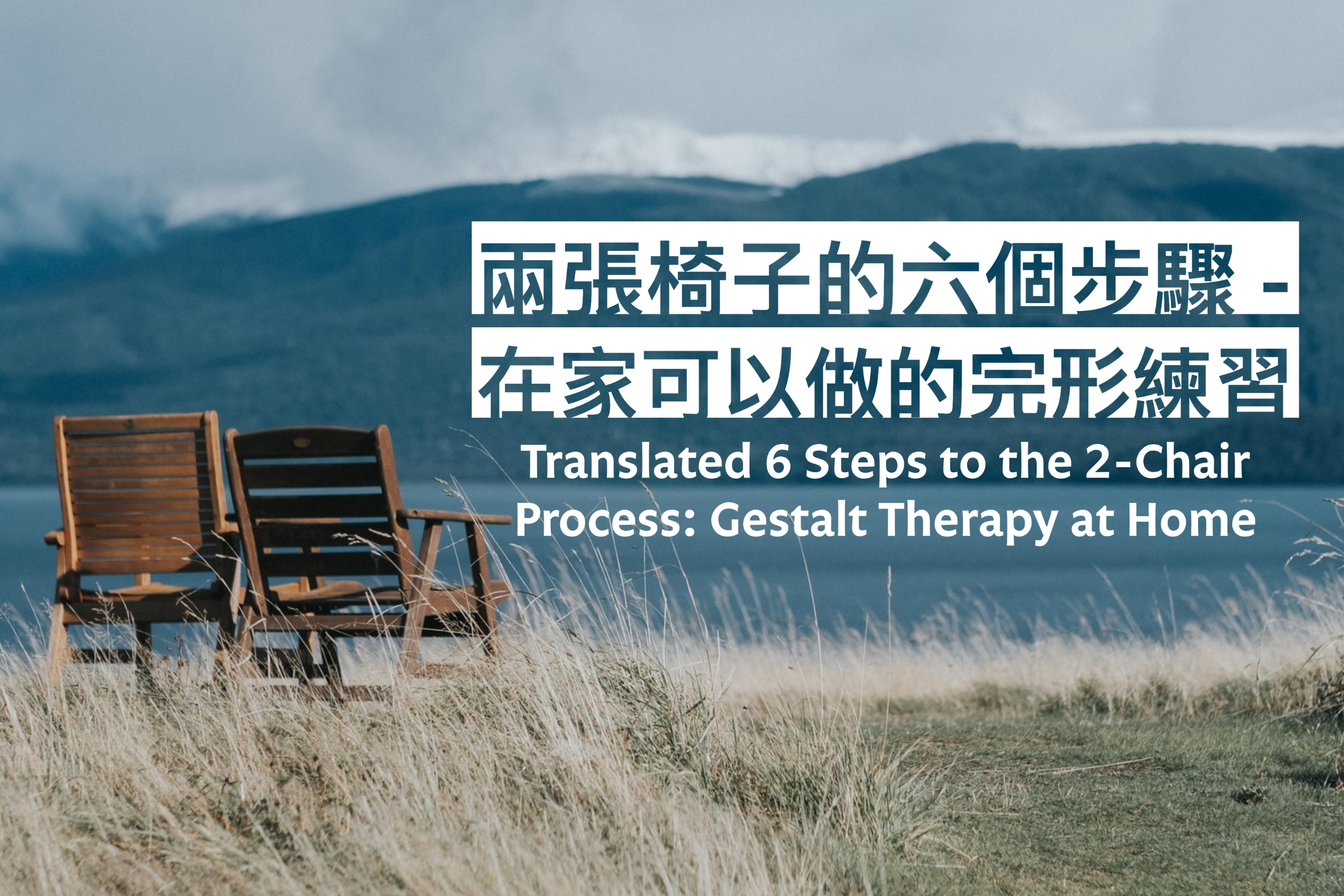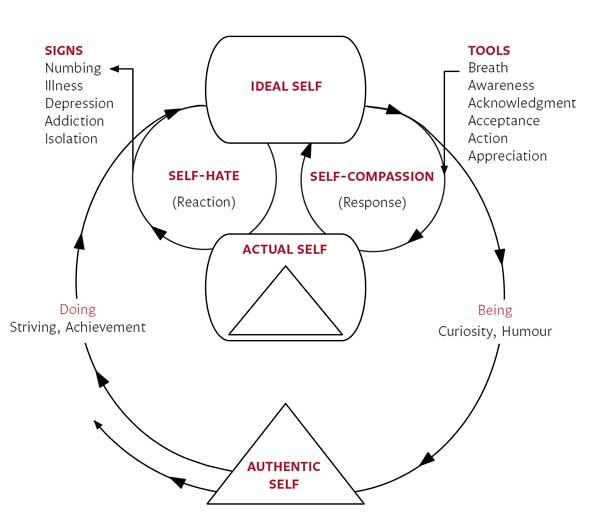兩張椅子的六個步驟 – 在家可以做的完形練習
6 Steps to the 2-Chair Process: Gestalt Therapy at Home
兩張椅子的六個步驟 – 在家可以做的完形練習
By Wayne T. Dodge MD, MPH, DipC
Written on March 29, 2020
Translation Note:
翻譯說明:
This article on the Haven website was written by Wayne Dodge during the COVID impact on the world. On the Chinese-English Bilingual Program “Awakening from the Past” co-led by Graemme Brown and myself in April 2021, we taught the concept of Gestalt and provided this translation of the article to our participants. We wish with this linking and connecting of all our friends we are sending our blessings to Wayne who is now struggling in his recovery process. We wish our beloved Wayne who has transformed so many lives of us: You will receive our prayers to you – Compassion, Courage, Grace, and Early Recovery.
Translator: Wen-Shwu Lee
這篇文章在Haven海文的網站上,由Wayne老師在疫情壓力衝擊全世界的時候所發表。在2021年四月份Graemme老師和我共同帶領的「Awakening from the Past 從過去覺醒」的課程中,我們特別將此文章翻譯成中文,分享給全球的朋友們,希望經由這份連結來傳遞我們的祝福給目前正在病痛中掙扎的Wayne,祝願這位改變我們許多人生命的海文導師Wayne:慈悲勇氣,恩典滿溢,早日康復。
譯者:李文淑
April 18, 2021
The Original Article:
原文如下:
If you‘ve been to Come Alive at The Haven, there’s a good chance you’ve participated in or witnessed some Gestalt-type work or more specifically what is called a “2-chair process.” Many participants have found profound healing and transformation with this modality.
假如你曾經參加過海文的「潛力蘇醒」課程,可能你曾經參與或見證過有關於完形的工作,或者更精準的說,叫做「兩張椅子的對話。」許多學員發現這種形式的練習可以帶來深入的療癒和轉化的效果。
Although I have a strong preference for work in groups – or at least with an other person – in this time of physical distancing this may not always be possible. If there is something that you’re wanting to work on and there is no immediate ‘other’ – either physically present or available through the miracle of Skype/Zoom/FaceTime etc. – the processes that we use at The Haven can still be used profitably.
雖然我非常喜歡和團體一起工作,或者至少是跟著另外一個人在一起工作,但是疫情壓力和保持社交距離的現實中,恐怕以上都不是很方便了。這個時候如果你有一些議題要處理,而身邊又沒有立即的「他人」在,沒有本人在,或是無法經由社交媒體可連線上,例如Skype/Zoom/Facebook/WeChat,這時候海文常用的完形練習就可以提供許多的好處。
The 2-chair process is a technique most often associated with Gestalt Therapy – and specifically with Fritz Perls. In this process, the client identifies a ‘name-able’ thing/other with whom they are having ‘stuck energy’. Stuck-ness is most often identified as being a problem, an attraction, an obsession, … This can be with another person (my mother, my partner, my boss, …) – or a ‘part’ of myself – (my self-hate, my anger, my fear, …) – or even an idea/concept/group … – (COVID, the Church, Republicans, …). The key is being able to ‘name’ this – and preferably with a relatively simple name. The reason for simplicity will be obvious as we proceed.
兩張椅子的練習技巧是與完形治療相關的,特別是弗里斯·皮爾斯的完形理論( 德國心理學家,完形療法的創始人)在這個過程中,客戶要決定一個可以取名的事物或是人,針對這個對象他們有卡住的能量,這個卡住的能量通常被認為是一個問題,一種吸引力,或是一種執著 … 這可能是跟另外一個人(比如說:我的母親,我的伴侶,我的老闆 …)或是我身體的某個部分(比如說:我的自恨,我的憤怒,我的恐懼 …)甚或是一個想法,概念,或是一個團體(比如說:疫情,教會,或是政黨 …)關鍵是能夠把這個對象取名,最好是有關連性的簡單名字,名字的簡單性等一下我們說明下列步驟時,你就會比較清晰原因。
How to do a 2-chair process (in the midst of a pandemic):
如何做兩張椅子的完形練習(在疫情壓力中)?
The first step in 2-chair work is to confirm your intention in the work. This is a process designed to uncover, explore, further understand the dynamic that is happening (the ‘stuck-ness’ of the energy). It is NOT designed/intended to resolve, complete, solve or fix the stuck-ness. This is a possible outcome of the process, but not its intent. The ‘success’ of 2-chair work depends on avoiding focus on a specific desired outcome (as best as we’re able). The intent is to remain in ‘here-and-now’ as much as possible to discover (uncover) the ‘what-is-ness’ of what is happening.
兩張椅子的完形練習首先要確認你的意圖。完形工作的設計是要誏我們發現、探索以及深入了解當下能量的變化(卡住的能量。)完形的目的不是用來解決或修復這些卡住的能量,這只是一種可能的結果,然而不能當成我們的意圖。完形工作的「成功」要盡可能地避免將我們的焦點放在期待特定的結果上,我們的意圖在於盡可能地保持當下,誏我們持續的發現此時此地正發生了什麼。
If my firm intention is such a specific outcome – this does NOT mean that I cannot proceed – it only limits the possibilities of what can unfold. And I might wish to expend my energy elsewhere. Particularly if I have done something similar before – and are back at the same ‘starting place’; it may be that I’m actively participating in re-creating the ‘trauma’ that I’m attempting to ‘fix’. It is always your choice to proceed if you wish, but please keep in mind the definition of insanity (doing the same thing over and expecting a different outcome).
假如我清楚的意圖就是要求一個明確的結果,這並不表示我不能進行,只是這麼作會限制了我們探索的可能性。我也許會希望把我的能量用在探索別的方向上,特別是之前我已經做過類似的探索了,然而又回到同樣的原點,這可能是因為我想要「解決」問題的企圖心,反而誏我積極地參與了重複「創傷」的經驗。當然持續這麼做也是你的選擇,但請記得失去理智就是意指:我們不斷重複同樣的事,卻又期待不同的結果。
Then, if doing this on your own, you will need to keep a part of yourself ‘apart’ – as an observing ego/leader. Like any good leader, this portion of yourself may fade into the background, but if at any time the process feels too chaotic/ungrounded, the observing ego is the energy to come forward and ‘take charge.’
其次,假如你是一個人自己做完形,你會需要將你自己的一部份的能量「分開來,」成為一個觀察自己的帶領人。和其他優秀的帶領人一樣,這部分的你要慢慢退到背景中。但在任何時間,如果覺得這個過程太混亂,或者失去立足點了,這位觀察自我的帶領人的能量就要適時的往前成為主導。
Then proceed to the process itself. This requires physicalizing the two ‘parts’ – ‘me’ and whatever it is that I have named – the ‘named-thing’. This will require two chairs or cushions – and the ability to move from one to the other.
至於完形工作的進行步驟,我們需要兩個能表達的實體「部分」存在,一個是我,和另外一個我取名的事物或是對象,我們需要兩張椅子,或是兩個枕頭,而且要能夠互相交換位置。
6 Steps to the 2-chair process (while social distancing):
兩張椅子完形工作的六個步驟(在保持社交距離中):
Identify and reflect on what you want to say to the ‘named -thing’ sitting across from you:
先思考並確定你想要說話的對象,將它取一個名字,讓這「被取名的對象」坐在你對面:
1. Breathe
- 呼吸
This is most often focused, slightly hyper-ventilatory breathing – to ‘charge’ the process – bring more energy into the ‘here-and-now.’
這通常是專注並且有點過度的深呼吸,好讓整個過程充滿了能量,允許更多的能量進入當下「此時此地。」
2. Begin talking to the ‘named -thing/person.’
- 開始對這「被取名的對象」說話
Using the name, speak to it as if it were a real thing sitting in front of you.
叫對方的名字,開始對它說話,彷彿這個對象真的坐在你對面。
3. Continue speaking.
- 持續說話
As long as there is ‘energy’ in the words, keep going. Once the energy starts to wane, fade, falter move on to Step 4.
只要言詞表達上仍然充滿能量就持續進行,一旦這個能量開始消褪,我們就進行到下一步驟 4。
4. Move over onto the other cushion.
- 換位坐到對面的椅子或枕頭上
Take several breaths to ‘energize’ and ‘become’ the ‘named -thing’. Bring the qualities/nature of the ‘named -thing’ to mind and move your body into an expression of those qualities. Then respond to what you (now the ‘named -thing’) have just heard from the ‘you’ who was sitting in the opposite chair. Continue talking as long as there is a sense of ‘energy’ in what is being said. Once that wanes/fades/falters/… Pause, and if nothing else arises, continue to Step 5.
幾口深呼吸激發你的能量,誏自己成為那個「被取名的對象,」想像那個「對象」的品質和個性,然後啓動你的身體來表達這些特質,回應你(你現在是這個「被取名的對象」)剛剛聽到從對面的你所說的話。持續對話 – 只要對話中持續有能量的流動,一旦這股能量消散時,就暫停,假如沒有其他的事情需要再表達,我們就進入下一個步驟5。
5. Move back onto the original chair.
- 回到原來的椅子上。
Breathe and reflect on what has just been said – and see if there is more to express. If so, continue back and forth until there is no more ‘movement’ of energy – or you’ve reached whatever time limit you have. End up in the first chair (that is as ‘you’, not the ‘named’ thing).
呼吸並回顧剛剛所說的,看看是否還有更多需要表達,假設有,就繼續來來回回換位,直到對話之間沒有再多的能量流動,或是你的時間到達某一個侷限。結束時要坐回屬於自己的第一張椅子上,是「你」自己的椅子,而不是那張被「取名」的椅子。
6. Breathe
- 呼吸
Reflect on your experience.
回顧你的經驗。
Hints:
建議:
- Use the name of that which is in the chair opposite you repeatedly and often. This often helps with keeping the energy alive. You can see that if you’re talking to “He-Who-Must-Not-Be-Named” and have to say that repeatedly, whatever drama is taking place often switches into comedy. So, keep the name as simple as possible.
重覆並頻繁的稱呼坐在你對面椅子上的名字,這常常可以幫助你持續活絡你的能量。現在你能夠明白了,假如你要跟一個冗長的名字,比如說「那位-無法-命名-的他」要不斷地重覆地叫這個名字,那麼這場劇很快就變成鬧劇了!所以盡量讓這個對象的名字越簡單越好。
- If energy is starting to lag, check to see if you’re still breathing actively first, before doing any switch of chair.
假如能量開始變得比較遲緩,在換位之前先檢視一下,你是否仍在積極的呼吸。
- If you move to a complementary process (such as physical expression of anger), make sure that it is ‘you’ and not the ‘named-thing’ doing that.
假如你進入到某些輔佐的工作(比如說:用肢體做憤怒的表達,)要確定做這些輔佐工作的人是「你」自己,而不是「取名的對象。」
- If you‘re having any difficulty with the process, remember you can always stop it by opening your eyes, focusing on something in the room and slowing your breathing. Just keep your focus on something present in the room and focus on keeping your breathing slow for a couple minutes. If there is someone else with you, even better – look into their eyes and keep your breath slowed down. Then you can look back and consider ‘where’ and ‘how’ you became ungrounded – and possibly understand more of the ‘why’. This is also valuable learning.
假如你在過程中遇到任何困難,請記得:你總是可以隨時喊停,張開眼睛,注視房間內某個物件,放慢呼吸。就是幾分鐘的時間聚焦在注視房間內某個物件,並且放慢呼吸。假設有人在身旁,這樣更好,你可以看著那個人的眼睛,讓你的呼吸放慢。之後你可以回顧一下是什麼「地方」以及「如何」自己失去了立足點,也許更了解「為什麼,」這都是非常有價值的學習。
Be compassionate with yourself afterwards. Give yourself time to witness your work – and be witnessed by yourself – this is often the greatest time of ‘healing’ – in the understanding that can come after the official ‘process’.
完形練習結束後要對自己慈悲,給自己一些時間來見證自己所做的工作 – 讓自己被自己見證 – 如何我們在步驟走完之後去做了解和學習,這通常都是非常重要的療癒,。
About the Author:
有關作者
Wayne Dodge MD, MPH, DipC has been associated with The Haven since 1981. He was the Clinical Director of an 18-practitioner Medical Clinic and administered the AIDS program for a large medical organization for 15 years. He has led Come Alive, Living Alive 1: Self Awareness, and Haven-Style Theories & Practices of Transformation (formerly: New Horizons: Phase III). With Gwen Ewan, he co-created Self-Compassion and a series of programs on Haven skills. He is a proud grandfather who is enjoying retirement and spending time in Seattle with his husband and partner of more than 30 years.
韋恩道奇自1981年就參與海文的教育工作,他是一位臨床主任醫師,有18年醫療的經驗,曾經在一個大規模的醫療中心管理AIDS專案有15年的經驗。他在海文學院帶領的課程有潛力甦醒、階段一自我覺察、以及海文教育的理論與實務(之前稱作階段三新視野。)和Gwen Ewan老師,他們一起設計的課程有:自我疼惜和一系列海文的技術課程。他很驕傲自己升格為外公了,很享受他的退休生活,他在西雅圖和他的伴侶一起生活了30多年。






